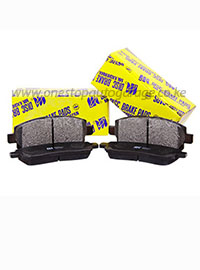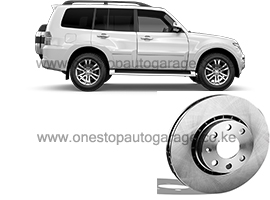-6%
Find the best Prices for Front Brake Disc Mitsubishi Pajero V93 V98 in Nairobi, Kenya
Brake discs, often referred to as brake rotors, are integral components of a vehicle’s braking system, playing a pivotal role in slowing down and stopping the vehicle. As a fundamental part of disc brake systems, brake discs undergo substantial stress during everyday driving. Understanding their importance and recognizing signs of wear is crucial for maintaining optimal braking performance, ensuring vehicle safety, and preventing potential issues that could compromise the effectiveness of the braking system.
Importance of Brake Discs:
- Friction for Deceleration: Brake discs are essential for the deceleration of a vehicle. When the brake pedal is engaged, brake calipers squeeze brake pads against the rotating brake discs. This frictional interaction converts the kinetic energy of the moving vehicle into heat, effectively slowing it down and bringing it to a controlled stop.
- Heat Dissipation: Brake discs play a critical role in dissipating the immense heat generated during the braking process. As the brake pads create friction against the spinning discs, heat is generated. Efficient heat dissipation is vital to prevent brake fade, a condition where braking performance diminishes due to excessive heat buildup. Well-designed brake discs with effective cooling mechanisms help maintain consistent braking performance under varying conditions.
- Durability and Longevity: Brake discs are subjected to significant wear and tear, and their durability is paramount for the overall lifespan of the braking system. High-quality materials and precision engineering contribute to the longevity of brake discs. Regular maintenance and proper usage ensure extended durability, reducing the frequency of replacements and associated costs.
- Consistent Braking Performance: Maintaining consistent braking performance is essential for driver confidence and safety. Brake discs, when in good condition, provide a smooth and predictable response to braking inputs. Even distribution of braking force and minimal runout (wobbling) contribute to a stable and controlled braking experience, enhancing overall vehicle safety.
- Compatibility with Brake Pads: Brake discs are designed to work in tandem with brake pads. The composition, surface finish, and design of brake discs are optimized to complement the characteristics of specific brake pad materials. This compatibility ensures efficient braking, minimizes noise, and reduces wear on both the brake discs and pads.
Signs of Worn-Out Brake Discs:
- Scoring or Grooving: Excessive wear on brake discs can result in scoring or grooving on their surfaces. These are visible indentations caused by prolonged contact with worn brake pads. If the discs exhibit deep grooves or scoring, it indicates significant wear, and replacement is recommended to maintain optimal braking performance.
- Visible Cracks or Warping: Inspecting brake discs for visible cracks or warping is crucial. Cracks can compromise the structural integrity of the discs, while warping can lead to uneven contact with the brake pads, causing vibrations during braking. Any signs of cracks or warping are clear indicators that the brake discs should be replaced promptly.
- Reduced Thickness: Brake discs have a minimum recommended thickness to ensure structural integrity and effective heat dissipation. Over time, due to wear, discs may thin beyond the specified limit. Measuring the thickness of the brake discs during routine inspections is essential. If they fall below the recommended thickness, replacement is necessary to maintain braking efficiency.
- Excessive Rust and Corrosion: Rust and corrosion on the brake disc surfaces can compromise braking performance. While some surface rust is normal, excessive corrosion may affect the smooth operation of the brake pads and reduce friction. Regular cleaning and inspection can help prevent severe rusting, but if significant corrosion is present, replacement is advised.
- Pulsation or Vibrations During Braking: Warped or unevenly worn brake discs can cause pulsation or vibrations felt through the brake pedal during braking. This phenomenon, known as brake judder, is a clear indication of an issue with the braking system. Addressing this symptom promptly is essential to prevent further damage and ensure a smooth and controlled braking experience.
- Squealing or Grinding Noises: Worn-out brake discs can produce audible warning signs such as squealing or grinding noises during braking. These noises may be attributed to worn brake pads or the metal-to-metal contact between the pads and severely worn discs. Immediate inspection and replacement of both brake pads and discs are necessary to address this issue.
- Reduced Braking Efficiency: A noticeable reduction in braking efficiency is a critical sign of worn-out brake discs. If the vehicle takes longer to come to a complete stop or if the braking force feels inconsistent, it indicates that the brake discs may be nearing the end of their effective life. Timely replacement is crucial for maintaining optimal safety on the road.
Conclusion:
Brake discs are integral to the safety and performance of a vehicle’s braking system. Regular inspections, attentive listening for unusual noises, and prompt replacement when signs of wear are observed are essential practices for vehicle maintenance. Recognizing the importance of brake discs and addressing wear-related issues contribute to sustained braking efficiency, overall vehicle safety, and a confident driving experience. By staying vigilant and responsive to signs of worn-out brake discs, vehicle owners can ensure the reliability and effectiveness of their braking systems, promoting safe journeys on the road.



